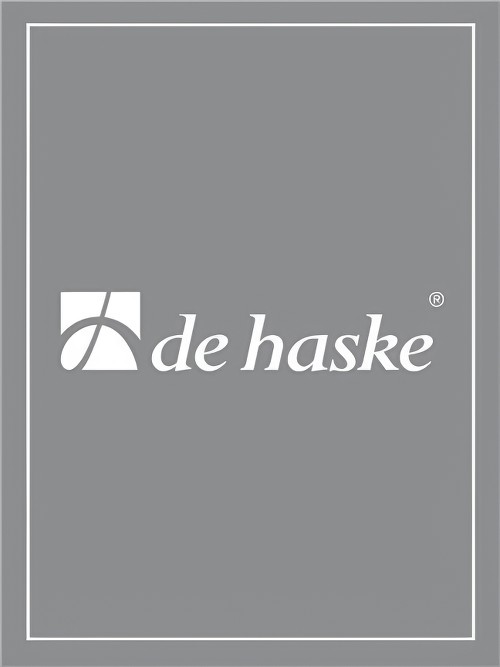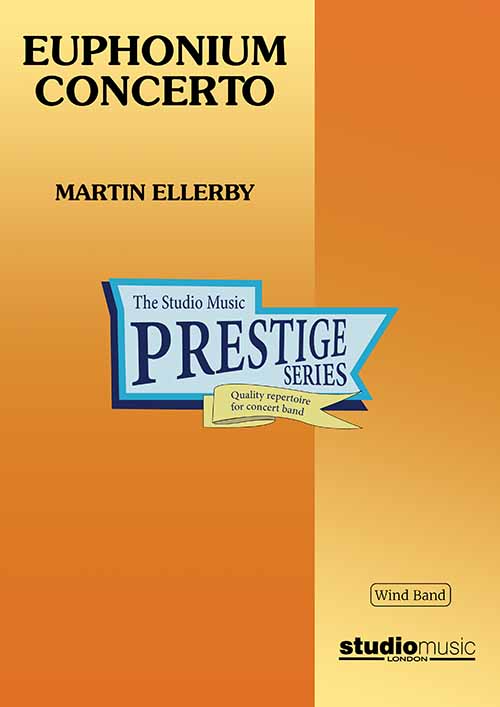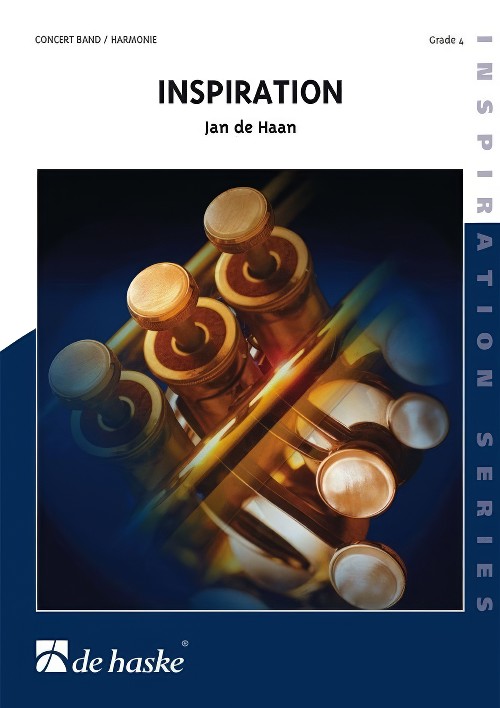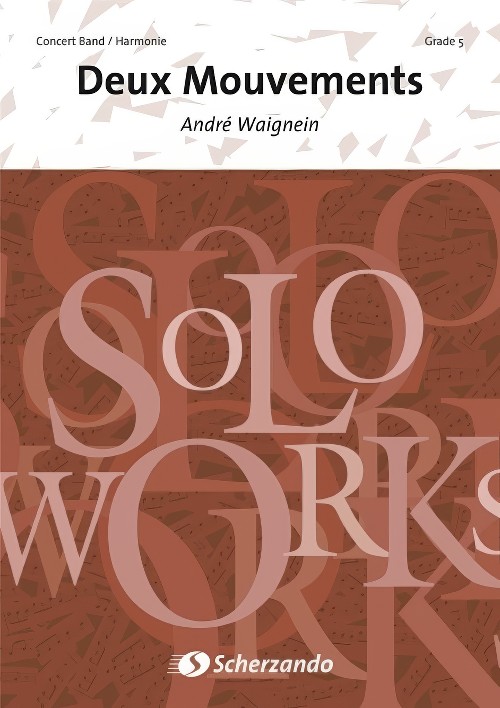Results
-
 £67.50
£67.50You'll Never Walk Alone (Concert Band - Score and Parts) - Hammerstein & Rodgers - Oud, Thijs
This great football anthem is now infamous as the song sung by 'the kop' at Liverpool Football Club. It was however made famous worldwide when it was sung against the background of the Eiffel Tower to close the 1998 World Cup. It can now be played and enjoyed by your concert band with this great arrangement. An ideal piece to close any concert.Duration: 2:10
Estimated dispatch 7-14 working days
-
 £164.95
£164.95Euphonium Concerto (Concert Band - Score and Parts) - Ellerby, Martin
This Euphonium Concerto was written between late 1994 and early 1995 in response to a commission from Steven Mead to whom the work is dedicated. It is cast in four movements and lasts a little over 22 mins:I. Fantasy: After the briefest of introductions, the solo euphonium enters with the key melodic phrase of the movement in a fast 'Tempo I'. This idea is developed up to the point where a slower 'Tempo II' breaks the argument - here the mood is reflective but it is only to be a brief interruption as 'Tempo I' returns very quickly. The opening material is then subjected to further transformation with 'Tempo II' making occasional returns en route, the distances between the contrasting tempi becoming ever closer, and the movement closes in a rather soft though definite manner.II. Capriccio: This relatively short presto movement forms a bridge between the first movement and the work's slow movement. The majority of the band parts are bright and muted with the percussion players enhancing the texture with contributions from xylophone, glockenspiel and vibraphone. Again the initial solo euphonium phrase provides the basis for almost all the movement's material. This is extremely virtuosic for the soloist and band alike and makes great play of the rhythmic possibilities of combining simple and compound music either in close proximity or together.III. Rhapsody (for Luis): A Lento movement, sitting between two different but essentially rapid ones, this provides the work's emotional core exploiting the soloist's cantabile qualities in an almost seamless fashion. Again, as will all the work's movements, the initial idea paves the way for subsequent development, eventually culminating in a passionate climax; thereafter it winds down with an affectionate backward glance towards the close of the the slow movement of the Euphonium Concerto of Joseph Horovitz, whose mark had been made indelibly on the euphonium repertoire. This movement is dedicated to Luis Maldonado who set the full score of the brass version before his untimely death.IV. Diversions: The work's variation finale is cast in 3/4 throughout though the barline is often a guideline and was seen by the composer as a challenge of metrical restraint! There is an obvious jazz feel to this movement (both rhythmically and harmonically) with a swaggering ritornello theme first announced by the solo euphonium. Thereafter follows a series of interludes and 'adjusted' returns of the main theme. A lyrical idea is allowed to enter but the underlying momentum is ever present. The band also contributes to the interludes and eventually the tempo increases towards a 'wild' and absolute conclusion.Duration: 22.30Recorded on QPRM143D Dreamscapes, Royal Northern College of Music Wind Orchestra
Estimated dispatch 7-14 working days
-
 £32.95
£32.95Euphonium Concerto (Concert Band - Score only) - Ellerby, Martin
This Euphonium Concerto was written between late 1994 and early 1995 in response to a commission from Steven Mead to whom the work is dedicated. It is cast in four movements and lasts a little over 22 mins:I. Fantasy: After the briefest of introductions, the solo euphonium enters with the key melodic phrase of the movement in a fast 'Tempo I'. This idea is developed up to the point where a slower 'Tempo II' breaks the argument - here the mood is reflective but it is only to be a brief interruption as 'Tempo I' returns very quickly. The opening material is then subjected to further transformation with 'Tempo II' making occasional returns en route, the distances between the contrasting tempi becoming ever closer, and the movement closes in a rather soft though definite manner.II. Capriccio: This relatively short presto movement forms a bridge between the first movement and the work's slow movement. The majority of the band parts are bright and muted with the percussion players enhancing the texture with contributions from xylophone, glockenspiel and vibraphone. Again the initial solo euphonium phrase provides the basis for almost all the movement's material. This is extremely virtuosic for the soloist and band alike and makes great play of the rhythmic possibilities of combining simple and compound music either in close proximity or together.III. Rhapsody (for Luis): A Lento movement, sitting between two different but essentially rapid ones, this provides the work's emotional core exploiting the soloist's cantabile qualities in an almost seamless fashion. Again, as will all the work's movements, the initial idea paves the way for subsequent development, eventually culminating in a passionate climax; thereafter it winds down with an affectionate backward glance towards the close of the the slow movement of the Euphonium Concerto of Joseph Horovitz, whose mark had been made indelibly on the euphonium repertoire. This movement is dedicated to Luis Maldonado who set the full score of the brass version before his untimely death.IV. Diversions: The work's variation finale is cast in 3/4 throughout though the barline is often a guideline and was seen by the composer as a challenge of metrical restraint! There is an obvious jazz feel to this movement (both rhythmically and harmonically) with a swaggering ritornello theme first announced by the solo euphonium. Thereafter follows a series of interludes and 'adjusted' returns of the main theme. A lyrical idea is allowed to enter but the underlying momentum is ever present. The band also contributes to the interludes and eventually the tempo increases towards a 'wild' and absolute conclusion.Duration: 22.30Recorded on QPRM143D Dreamscapes, Royal Northern College of Music Wind Orchestra
Estimated dispatch 7-14 working days
-
 £139.99
£139.99Inspiration (Concert Band - Score and Parts) - De Haan, Jan
Inspiration was commissioned by the Solothurnischer Kanotonal Musikverband in Switzerland in 1993. The composition begins with an A-theme written in a Phrygian tonality and, after an enormous climax, moves on into a quicker B-section, characterized by the use of wide interval jumps. Then follows the development in which both themes return individually and together. Peace and quiet is restored in the slow middle movement, based on the B-theme. The movement comes to a close with a tutti B-theme, brutally interrupted by fragments from the A-theme. Without a break, the final movement of this contrastive piece develops from these fragments. The theme of this extremely rhythmical closing movement is built up of elements from the A-theme, whilst the B-theme (from the slow middle movement) returns in full once more. Before the piece comes to a close in a resounding fortissimo, the cornet soloist performs the A-theme from the back of the auditorium, to special effect.Duration: 10:00
Estimated dispatch 7-14 working days
-
 £154.99
£154.99Deux Mouvements (Alto Saxophone Solo with Concert Band - Score and Parts) - Waignein, Andre
Early in 1989 Jean Baily, director of the Royal Conservatoire in Bruxelles, asked his very close friend Andre Waignein to compose a piece which could be performed by the conservatoire's saxophone class. Andre Waignein was readily agreeable. Not only was his father a saxophone player, but himself felt strongly attracted to the instrument and he was further encouraged into accepting the commission by his friend Alain Crepin, saxophone teacher at the Bruxelles Conservatoire.The piece he composed consists of two movements, hence the title. An elegy is expressed by means of a melody which is full with pronounced magnanimity, full of spectacular musical freedom enabling the soloist to express himself to the full. In this movement the melodic element is of the utmost importance.The capriccio, the second movement is musically disconcerting. The band's accompaniment is particularly important. Due to the high notes, the soloist brings this capriccio to a close with enthusiastic virtuosity.Duration: 9:15
Estimated dispatch 7-14 working days
-
 £64.35
£64.35A Quiet Journey Home
Based on the well known spiritual, "His Eye Is On The Sparrow", this Grainger-esque setting is an outstanding programming choice for better bands. Pitched in the key of Db, the close harmonies require mature legato phrasing and close attention to dynamics at a slow tempo. Challenging, but well worth the effort, "A Quiet Journey Home" is an eloquent composition that will allow your group to expand its musical horizons. Very highly recommended!
Estimated dispatch 7-14 working days
-
 £89.99
£89.99Eternal Friendship - Satoshi Yagisawa
This work is a close-up of the encounters and relationships of trust between people, following the idea that "friendship lasts forever." After the passing of Satoshi Yagisawa's close friend and work partner, Tsutomu Murata, a designer of Neo Create in August 2020, the composer began work on this piece. Murata performed music for audiences primarily as a leader and conductor of Kurume City Brass, a group which is active in Fukuoka Prefecture in Japan. Eternal Frienship depicts a five-minute chorale which explores "how music can convey that a close friend is indispensable to you, more broadly, everyone to someone," much like how Murata conveyed the appeal of music to his audiences. Under the direction of the composer himself, the work had its world premiere and was recorded with the Kobe College Wind Orchestra.
Estimated dispatch 7-14 working days
-
 £202.99
£202.99Missa Tornacum - André Waignein
Flicien Doyen, the President of the Tornacum Royal Choir Circle of Tournai (Belgium) and a close friend of the composer commissioned this Mass. Missa Tornacum was originally composed for mixed choir and organ, gave a memorable performance of thepiece in the Chartres Cathedral in France.Although it does not include the Credo, the work is composed according to the traditional structure of a Mass in five parts : Kyrie, Gloria, Sanctus, Agnus Dei, and Ite missa est. En the first two parts, adialogue is created between the choir and the band. It is followed by the Sanctus cycle ("Sanctus" - "Hosanna" - "Benedictus"), which is remarkable for the contrasts between the tone colorscharacterizing each of its three parts. The fourth part,Agnus Dei, takes on a tone of serene intimacy. A free counterpoint draws this section to a close by fading into an almost imperceptible quietness. Ite missa est begins with a series of imitations, which develop into a majestic and cheerful passagemarking the end of the Mass. Choir parts are available separately.
Estimated dispatch 7-14 working days
-
 £71.50
£71.50A Quiet Journey Home - Shabazz
Based on the well known spiritual, "His Eye Is On The Sparrow", this Grainger-esque setting is an outstanding programming choice for better bands. Pitched in the key of Db, the close harmonies require mature legato phrasing and close attention to dynamics at a slow tempo. Challenging, but well worth the effort, "A Quiet Journey Home" is an eloquent composition that will allow your group to expand its musical horizons. Very highly recommended!
Estimated dispatch 7-14 working days
-
 £154.99
£154.99Deux Mouvements - André Waignein
Early in 1989 Jean Baily, director of the Royal Conservatoire in Bruxelles, asked his very close friend Andr Waignein to compose a piece which could be performed by the conservatoire's saxophone class. Andr Waignein was readily agreeable. Not only was his father a saxophone player, but himself felt strongly attracted to the instrument and he was further encouraged into accepting the commission by his friend Alain Crepin, saxophone teacher at the Bruxelles Conservatoire.The piece he composed consists of two movements, hence the title. An elergy is expressed by means of a melody which is full with pronounced magnanimity, full of spectacular musical freedom enabling thesoloist to express himself to the full. In this movement the melodic element is of the utmost importance.The capriccio, the second movement is musically disconcerting. The band's accompaniment is particulary important. Due to the high notes, the soloist brings this capriccio to a close with enthusiastic virtuosity.
Estimated dispatch 7-14 working days
